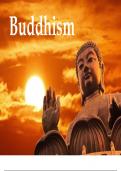Presentation
GCSE/A-Level Buddhism - Introductory Slides
This is a collection of 11 slides covering some of the key aspects of Buddhism: key beliefs, the Buddha, places of worship, geography/migration, holy texts, worship practices, and beliefs about (not) ‘God’. These slides have been made using a variety of sources. Feel free to edit, add, or...
[Show more]



